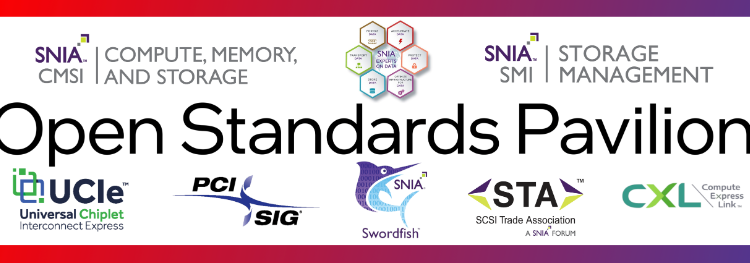


Edge AI Q&A

Addressing the Hidden Costs of AI

An Open Standard for Namespace Management
 ), an open ISO standard (ISO/IEC 17826:2022) for managing data objects and containers, already includes extensive capabilities for simplifying the management of complex namespaces.
In this webinar, you’ll learn Read More
), an open ISO standard (ISO/IEC 17826:2022) for managing data objects and containers, already includes extensive capabilities for simplifying the management of complex namespaces.
In this webinar, you’ll learn Read More

Confidential AI Q&A

How Edge Data is Impacting AI
AI is disrupting so many domains and industries and by doing so, AI models and algorithms are becoming increasingly large and complex. This complexity is driven by the proliferation in size and diversity of localized data everywhere, which creates the need for a unified data fabric and/or federated learning. It could be argued that whoever wins the data race will win the AI race, which is inherently built on two premises: 1) Data is available in a central location for AI to have full access to it, 2) Compute is centralized and abundant.
The impact of edge AI is the topic for our next SNIA Cloud Storage Technologies Initiative (CSTI) live webinar, “Why Distributed Edge Data is the Future of AI,” on October 3, 2023. If centralized (or in the cloud), AI is a superpower and super expert, but edge AI is a community of many smart wizards with the power of cumulative knowledge over a central superpower. In this webinar, our SNIA experts will discuss: Read More

Data Fabric Q&A
Unification of structured and unstructured data has long been a goal – and challenge for organizations. Data Fabric is an architecture, set of services and platform that standardizes and integrates data across the enterprise regardless of data location (On-Premises, Cloud, Multi-Cloud, Hybrid Cloud), enabling self-service data access to support various applications, analytics, and use cases. The data fabric leaves data where it lives and applies intelligent automation to govern, secure and bring AI to your data.
How a data fabric abstraction layer works and the benefits it delivers was the topic of our recent SNIA Cloud Storage Technologies Initiative (CSTI) webinar, “Data Fabric: Connecting the Dots between Structured and Unstructured Data.” If you missed it, you can watch it on-demand and access the presentations slides at the SNIA Educational Library.
We did not have time to answer audience questions at the live session. Here are answers from our expert, Joseph Dain. Read More

NVMe®/TCP Q&A

Open Standards Featured at FMS 2023
 (CXL
(CXL ), PCI-SIG®, and Universal Chiplet Interconnect Express
), PCI-SIG®, and Universal Chiplet Interconnect Express (UCIe
(UCIe ) in an Open Standards Pavilion, Booth #725, in the Exhibit Hall. CMSI will feature SNIA member companies in a computational storage cross industry demo by Intel, MINIO, and Solidigm and a Data Filtering demo by ScaleFlux; a software memory tiering demo by VMware; a persistent memory workshop and hackathon; and the latest on SSD form factors E1 and E3 work by SNIA SFF TA Technical work group. SMI will showcase SNIA Swordfish® management of NVMe SSDs on Linux with demos by Intel Samsung and Solidigm.
CXL will discuss their advances in coherent connectivity. PCI-SIG will feature their PCIe 5.0 architecture (32GT/s) and PCIe 6.0 (65GT/s) architectures and industry adoption and the upcoming PCIe 7.0 specification development (128GT/s). UCIe will discuss their new open industry standard establishing a universal interconnect at the package-level.
SNIA STA Forum will also be in Booth #849 – learn more about the SCSI Trade Association joining SNIA.
These demonstrations and discussions will augment FMS program sessions in the SNIA-sponsored System Architecture Track on memory, computational storage, CXL, and UCIe standards. A SNIA mainstage session on Wednesday August 9 at 2:10 pm will discuss Trends in Storage and Data: New Directions for Industry Standards.
SNIA colleagues and friends can receive a $100 discount off the 1-, 2-, or 3-day full conference registration by using code SNIA23.
Visit snia.org/fms to learn more about the exciting activities at FMS 2023 and join us there!
The post Open Standards Featured at FMS 2023 first appeared on SNIA Compute, Memory and Storage Blog.
) in an Open Standards Pavilion, Booth #725, in the Exhibit Hall. CMSI will feature SNIA member companies in a computational storage cross industry demo by Intel, MINIO, and Solidigm and a Data Filtering demo by ScaleFlux; a software memory tiering demo by VMware; a persistent memory workshop and hackathon; and the latest on SSD form factors E1 and E3 work by SNIA SFF TA Technical work group. SMI will showcase SNIA Swordfish® management of NVMe SSDs on Linux with demos by Intel Samsung and Solidigm.
CXL will discuss their advances in coherent connectivity. PCI-SIG will feature their PCIe 5.0 architecture (32GT/s) and PCIe 6.0 (65GT/s) architectures and industry adoption and the upcoming PCIe 7.0 specification development (128GT/s). UCIe will discuss their new open industry standard establishing a universal interconnect at the package-level.
SNIA STA Forum will also be in Booth #849 – learn more about the SCSI Trade Association joining SNIA.
These demonstrations and discussions will augment FMS program sessions in the SNIA-sponsored System Architecture Track on memory, computational storage, CXL, and UCIe standards. A SNIA mainstage session on Wednesday August 9 at 2:10 pm will discuss Trends in Storage and Data: New Directions for Industry Standards.
SNIA colleagues and friends can receive a $100 discount off the 1-, 2-, or 3-day full conference registration by using code SNIA23.
Visit snia.org/fms to learn more about the exciting activities at FMS 2023 and join us there!
The post Open Standards Featured at FMS 2023 first appeared on SNIA Compute, Memory and Storage Blog.
